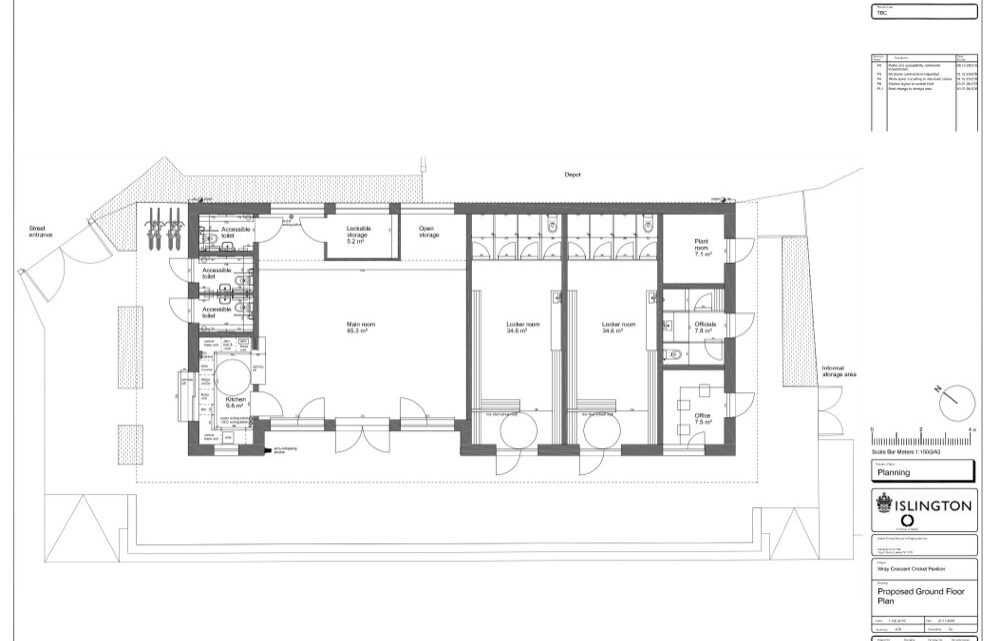
How to use Islington’s planning portal to examine the plans for our park.
Islington Council have presented their slightly revised plans for a new park building as a planning application. The council’s letter dated 29 February 2024 says that we have only until March 31 to make representations of objection, comment, or support, and that these must be submitted online – though the process is not easy.
How to use Islington’s planning portal for this application
We do not find the planning portal to be particularly user friendly, so we thought we’d write a short guide.
This is how it works:
- Visit Islington’s planning application search website here.
- Look for the Search Criteria, Application Number box.

- Now enter the number for the planning application, which is: P2024/0369/FUL
- Tap Search in the button below on the page.
- You’ll get to something that looks like this – it’s the portal to the planning application.

- Tap the numbers in green (because UI design doesn’t seem to be a thing on the planning portal) and you will reach a very basic page about the plans.
Please particularly look at
Once you get to the page, we’d like to draw your attention to two sections on the page – all of it is worth looking at:
Add Comments Here: This lurks near the top of the page and is where you can submit your comments concerning the plans. We have experienced problems sharing the link to this directly but try clicking this link. Otherwise follow the above steps.
Other information Available: There is lots of this, but pay particular attention to the Related Documents section, this is festooned with information to plough through. We’ve downloaded some of this to share from here, but there are 25 items available there. Here is a link to that page offering up all these items, which may not work (sorry, not us).
Here are four documents to get you started
We’ve taken the liberty of downloading four documents from the many provided that we think you should look at to understand the plans.
We do urge you to also take a look at a series of documents which provide additional insight into these plans, which are a series of Design and Access Statements (4 in all, available on the planning site).
But given time is precious, do take a look at the following documents while you figure out what you want to say about these plans:
- Planning Statement: This extensive document reveals that the office space included in the plan is for cricket development, which implies less community access to the space (p.16).
- Plans and pictures: Amusingly, these don’t include an image of the building as it will look throughout winter when the security grilles are closed.
- The public engagement summary report: We said at the time the consultation was flawed – it wasn’t representative or wide, and a post-COVID public consultation on the current set of plans should have been raised.
- The draft management plan: This plan is not to be seen as a final determination. But it seems to very little advance commitment to community use of this space.
The public engagement summary is particularly amusing, as it doesn’t really reflect how hard we had to work to get heard on these plans.
It is to Islington’s credit they did make some changes as a consequence of our input, but we still see problems with the proposals.
Criticisms of the proposed plans
The biggest is that the construction still bakes in a preference for one use above all other uses – at a budgeted cost of what seems to be £2 million including demolition of the existing structure.
Why is that use baked in? Take access – why is there no separate door so that community events can take place inside the hall during a match? Given our money is being spent on the building, we believe these things need changing.
Check back later for other suggestions, but right now we also see problems in the power and lighting system, duplication of a park keeper’s office, materials, roof design, the lack of solar panels, the impact on neighbouring trees and much more.
We think the project is receiving £1.56m of council funding, including £50,000 low carbon funding. This results in a project cost of approximately £7,600 per m2, which is nearly 2.5 times the Sport England benchmark figure of £3,200 per m2 for a similar construction. For twice as much cash, we think it’s reasonable to demand more value.
At the same time, the project has not described storage for football equipment – which the entire local community supports (hello Wrayvens!), nor does it solve the problem of where to store the unsightly 10m long cricket fencing poles currently placed in front of the pavilion, which again could be stored in the council compound.
One of our members has put together an alternative plan. This plan still provides improved facilities for the cricketers, but also delivers better vibes for the locals. What’s wrong with that? (We placed it below)

Why it matters
Please take a look at the plans and decide for yourself what you think. We’d urge you to share those thoughts with the planners – after all, the existing structure has been there for 50 years, which means the new building will also be there for a very long time. The least we can expect is that it contributes more to our community. The least we can demand is that we contribute to what will be there for the next few decades, and what it is for.
With this budget, there is an opportunity to build something enduring that contributes to local pride and also supports the game it is designed to support. But at present the construction does not deliver on that opportunity. Why build back average when the chance exists to build back better?